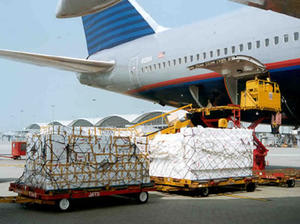Aviation securityAirports, carriers face additional costs as a result of 100 percent cargo inspections
On 1 August, 100 percent of air cargo carried on passenger planes in the United States must be screened for explosives and other illicit materials before the cargo is placed on the plane; this is up from the current level of 75 percent; DHS has already said it would not meet this deadline, but carriers are worried about the added cost nonetheless: electronic screening equipment is expensive, with some units costing as much as several hundred thousand dollars

Complete inspection of all air cargo will add enormously to the cost of shipping // Source: diytrade.com
South Florida’s multi-billion dollar air cargo industry is gearing up for a new security mandate that will make air travel safer — for passengers. The rule, which requires screening of all air cargo transported on aircraft carrying passengers, will increase costs for many freight customers and could cause shipping delays at Miami International Airport and other large airports in the United States.
Fort Lauderdale-Hollywood International Airport will also be affected, but to a much smaller degree. The Miami Herald’s Joseph A. Mann Jr. writes that in 2009 the Broward airport processed 90,432 tons of air freight, compared to 1.67 million tons at MIA. Moreover, only a very small percentage of Fort Lauderdale’s passenger flights will be impacted by the new rule, according to an airport spokesperson.
DHS’s plan was to start, on 1 August, to screen 100 percent of air cargo for explosives and other illicit materials before the cargo is placed on a passenger plane in the United States. This is up from the current level of 75 percent (DHS has admitted it would miss the deadline; see “TSA will miss 1 August air cargo screening deadline,” 8 July 2010 HSNW).
Some air cargo is carried by freighters, which have no passengers, but passenger aircraft also carry cargo as well as baggage. Passengers and baggage are already screened electronically or searched by Transportation Security Administration (TSA) agents.
Screening may be done by using electronic scanners and explosive sensors, by manual inspection or by packing boxes in a controlled, secure environment (like a pharmaceutical company) certified by the TSA. Electronic screening equipment is expensive, with some units costing as much as several hundred thousand dollars.
American Airlines, the largest carrier at MIA, has been working hard to prepare for the deadline. “We’ve spent well over $10 million on a variety of technological applications” to comply with TSA screening rules nationwide, said David Brooks, president of American Airlines Cargo Division, during a recent panel discussion in Washington, D.C. American, which has no freighters, carries all air cargo in the bellies of its passenger aircraft. Other airlines also have invested in cargo screening equipment, which is similar to the machines used to scan baggage — but much larger.
“Over the last three years, the law has stepped us up [to 75 percent], so we’re not starting at zero,” he added. “But the remainder will be the most challenging, because it will be consignments with the largest piece
